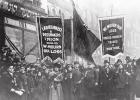When the 500 female employees of the Triangle Shirtwaist Factory came to work in Manhattan on March 25, 1911, they came with scant expectations. The concept of women in the workplace was not held in any esteem in this era. Poor women worked. Period. In fact, the majority of the factory’s employees were recent Italian and Jewish immigrants. While the youngest employees were around 14, it was common knowledge that practically any age of immigrant was eligible to work, provided the proper documentation could be forged. The options were simple. Sew women’s blouses for 60 hours a week to earn your $7 (for the entire week), or starve. Max Blanck & Isaac Harris, the owners of this establishment, weren’t concerned with safety measures or proper ventilation, hence the term sweatshop, because there were no labor laws protecting women. Their rules were simple: show up on time and work. Wanna break? Show up late? You’re out of luck. Starting time meant lockdown time for all doors & stairwells into and out of the 8th, 9th, & 10th floors of the Asch Building in Greenwich Village. The details on this day get fuzzy. Blanck and Harris were both on the premises this particular Saturday afternoon, with their children in tow, leading authorities to believe they weren’t culpable for the tragedy we’re about to discuss. Yet, they’d had very similar issues at four of their other companies. Whether it was a discarded cigarette tossed into two months’ worth of fabric cuttings in waste bins that were rarely emptied, the motors on long underserviced sewing machines, or the knowledge that something must be done since sales were down drastically on the now less popular garments, one thing was certain. The factory was on fire and there was no way to escape for many of the employees. In a macabre game of telephone, a bookkeeper on the 8th floor was able to contact the 9th floor, but there were no alarms and no phone system on the 10th floor. The fire department arrived, but were unable to intervene. The fire truck ladder was only tall enough to access the 7th floor. By nightfall, 146 people would be dead because of asphyxiation, the collapse of the single fire escape accessible but poorly anchored, burns, and willful jumps. The oldest victim was 43-year-old Providenza Panno. The youngest was 14-year-old Rosaria Maltese. Blanck & Harris were cleared of any wrongdoing and collected on their insurance policy at a later date.







